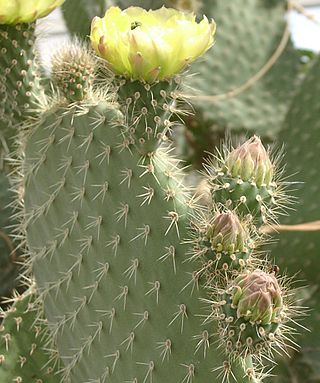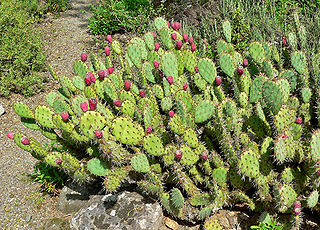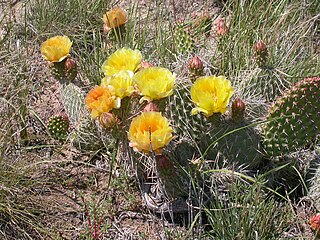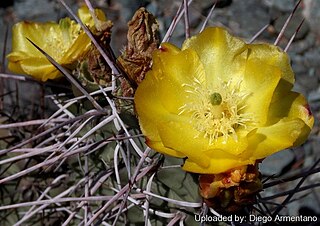
Opuntia ficus-indica, the Indian fig opuntia, fig opuntia, or prickly pear, is a species of cactus that has long been a domesticated crop plant grown in agricultural economies throughout arid and semiarid parts of the world. O. ficus-indica is the most widespread and most commercially important cactus. It is grown primarily as a fruit crop, and also for the vegetable nopales and other uses. Cacti are good crops for dry areas because they efficiently convert water into biomass. O. ficus-indica, as the most widespread of the long-domesticated cactuses, is as economically important as maize and blue agave in Mexico. Opuntia species hybridize easily, but the wild origin of O. ficus-indica is likely to have been in central Mexico, where its closest genetic relatives are found.

Opuntia engelmannii is a prickly pear common across the south-central and Southwestern United States and northern Mexico. It goes by a variety of common names, including desert prickly pear, discus prickly pear, Engelmann's prickly pear in the US, and nopal, abrojo, joconostle, and vela de coyote in Mexico.

Opuntia gosseliniana, commonly known as the violet pricklypear, is a species of cactus that is native to Pima County, Arizona in the United States and Baja California, Chihuahua, and Sonora in Mexico.

Opuntia stricta is a species of large cactus that is endemic to the subtropical and tropical coastal areas of the Americas, especially around the Caribbean. Common names include erect prickly pear and nopal estricto (Spanish). The first description as Cactus strictus was published in 1803 by Adrian Hardy Haworth. In 1812 he moved the species to the genus Opuntia.

Opuntia bentonii was proposed by some botanists to be a synonym of Opuntia stricta. However, O. bentonii, which grows in Texas, is separate and distinct from O. stricta.O. bentonii was clearly described by Griffiths in 1911. Along with O. stricta,O. bentonii was one of the pest pears of Australia in the early Twentieth Century.

Opuntia phaeacantha is a species of prickly pear cactus known by the common names tulip prickly pear, Mojave prickly pear, and desert prickly pear found across the southwestern United States, lower Great Plains, and northern Mexico. The plant forms dense but localized thickets. Several varieties of this particular species occur, and it also hybridizes easily with other prickly pears, making identification sometimes tricky.

Opuntia monacantha, commonly known as drooping prickly pear, cochineal prickly pear, or Barbary fig, is a species of plant in the family Cactaceae native to South America.

Opuntia leucotricha is a species of cactus with the common names: arborescent pricklypear, Aaron's beard cactus, and semaphore cactus; and duraznillo blanco and nopal blanco.

Opuntia basilaris, the beavertail cactus or beavertail pricklypear, is a cactus species found in the southwest United States. It occurs mostly in the Mojave, Anza-Borrego, and Colorado Deserts, as well as in the Colorado Plateau and northwest Mexico. It is also found throughout the Grand Canyon and Colorado River region as well as into southern Utah and Nevada, and in the western Arizona regions along the Lower Colorado River Valley.

Opuntia humifusa, commonly known as the devil's-tongue, Eastern prickly pear or Indian fig, is a cactus of the genus Opuntia present in parts of the eastern United States, Mississippi and northeastern Mexico.

Opuntia fragilis, known by the common names brittle pricklypear and little prickly pear, is a prickly pear cactus native to much of western North America as well as some midwestern states such as Illinois, Iowa, Wisconsin and Michigan. It also occurs in several Canadian provinces. It is known from farther north than any other cactus, occurring at as far as 56°N latitude in British Columbia. There is an isolated and possibly genetically unique population in Eastern Ontario known as the "Kaladar population".

Opuntia, commonly called prickly pear or pear cactus, is a genus of flowering plants in the cactus family Cactaceae. Prickly pears are also known as tuna (fruit), sabra, nopal from the Nahuatl word nōpalli for the pads, or nostle, from the Nahuatl word nōchtli for the fruit; or paddle cactus. The genus is named for the Ancient Greek city of Opus, where, according to Theophrastus, an edible plant grew and could be propagated by rooting its leaves. The most common culinary species is the Indian fig opuntia (O. ficus-indica).

Opuntia chlorotica is a species of plant in the family Cactaceae. It is a species of prickly pear native to the southwestern United States and northern Mexico. Its common names include pancake prickly pear, flapjack prickly pear and dollarjoint prickly pear.

Opuntia aciculata, also called Chenille pricklypear, old man's whiskers, and cowboy's red whiskers, is a perennial dicot and an attractive ornamental cactus native to Texas. It belongs to the genus Opuntia. It is also widespread in Nuevo Leon, Tamaulipas.

Opuntia aurantiaca, commonly known as tiger-pear, jointed cactus or jointed prickly-pear, is a species of cactus from South America. The species occurs naturally in Argentina, Paraguay and Uruguay and is considered an invasive species in Africa and Australia.

Opuntia polyacantha is a common species of cactus known by the common names plains pricklypear, starvation pricklypear,. and hairspine cactus, panhandle pricklypear. It is native to North America, where it is widespread in Western Canada, the Great Plains, the central and Western United States, and Chihuahua in northern Mexico. In 2018, a disjunct population was discovered in the Thousand Islands region of Ontario, Canada.

Opuntia macrocentra, the long-spined purplish prickly pear or purple pricklypear, is a cactus found in the lower Southwestern United States and Northwestern Mexico. A member of the prickly pear genus, this species of Opuntia is most notable as one of a few cacti that produce a purple pigmentation in the stem. Other common names for this plant include black-spined pricklypear, long-spine prickly pear, purple pricklypear, and redeye prickly pear.

Opuntia rufida is a species of prickly pear cactus native to southwestern Texas and northern Mexico, where it grows on rocky slopes. The species makes up for its total lack of spines with a profusion of red-brown glochids. The common name blind prickly pear or cow blinder comes from the fact that the glochids may be carried away by the wind and blind animals.

Opuntia atrispina is a cactus species in the genus Opuntia. It has limited distribution in the United States. In Texas it can be found from near Uvalde to Del Rio/Langtry—a small strip of area just 50 miles long.

Opuntia sulpurea falls under the Opuntia, or prickly pear, genus within the family Cacataceae named such because of their round shape, green color, and long thick spines. Opuntia sulphurea is the widest spread of the Opuntia that can be found in and around Argentina, occupying mostly arid areas of the region from the plains in the Western portion of Argentina up to much higher altitudes on the Eastern side of the Andes mountain range. As a result of its ability to survive in such a diverse array of environments there are several subspecies of O. sulphurea that are identifiable based on the number of spine per areole, for example. A commonality across the three is a bright yellow flower, often considered to be the color of sulfur, from which the species name is derived. As with several other species of Opuntia, these prickly pears tend to grow in groups, forming clumps that can reach one to two meters in diameter, but while other species within the genus grow upwards as well O. sulphurea tend to stay low to the ground. As a result of its tendency to grow in dry, arid, and rocky areas this cactus has evolved to be very resilient, not even suffering from the effects of agriculture, i.e. cattle grazing, on lower altitude subpopulations.




















